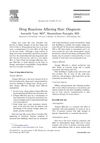Drug-Induced Changes in Hair Growth
August 1994
in “
Drugs & Therapy Perspectives
”

TLDR Some drugs can cause hair loss or growth, but hair usually returns to normal after stopping the drug.
The document discusses how various drugs can affect hair growth, causing hair loss (anagen or telogen effluvium) or hair gain (hirsutism or hypertrichosis). It lists numerous drugs associated with these effects and explains that hair growth typically normalizes after the cessation of the drug causing the abnormality. For patients undergoing chemotherapy, hair loss is rapid but regrowth occurs after treatment ends. Scalp cooling has been suggested to reduce alopecia during chemotherapy, but its effectiveness is uncertain and it may be uncomfortable and potentially increase the risk of scalp metastases. Telogen effluvium's onset is slower and may be dose-related for some drugs, such as lithium and interferons, but not for others. If drug therapy cannot be stopped, topical minoxidil may help restore hair growth. Drug-induced hirsutism and hypertrichosis are usually managed by discontinuing the drug or using cosmetic measures, and hypertrichosis may be dosage-dependent. The document also briefly touches on the economic and clinical considerations for antiulcer medication formulary decisions, including the mechanism of action, efficacy, tolerability, and cost.




